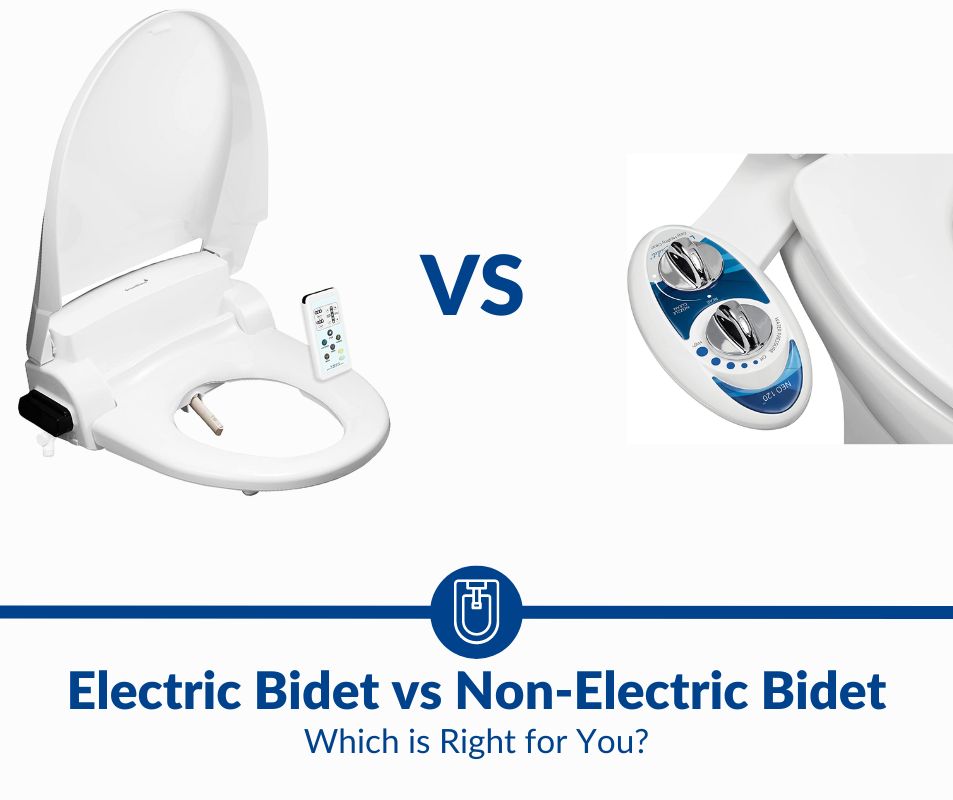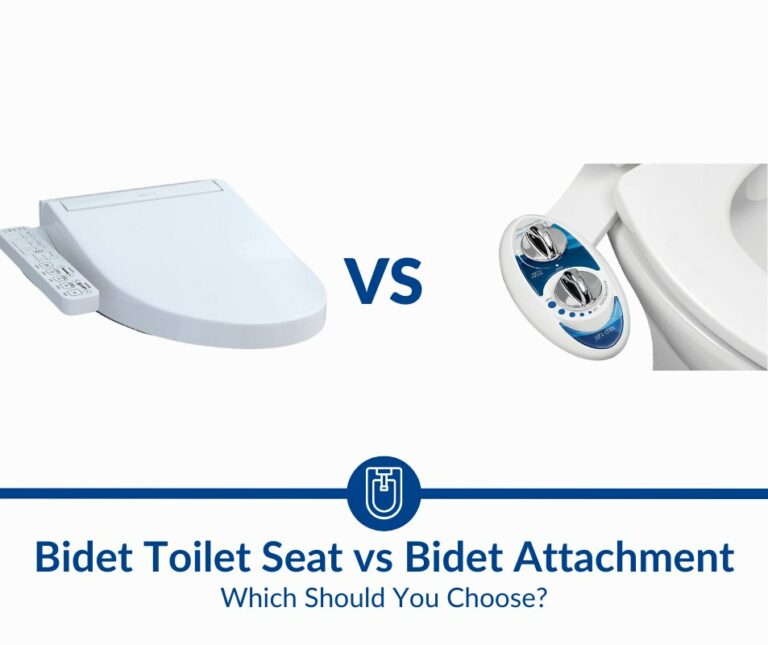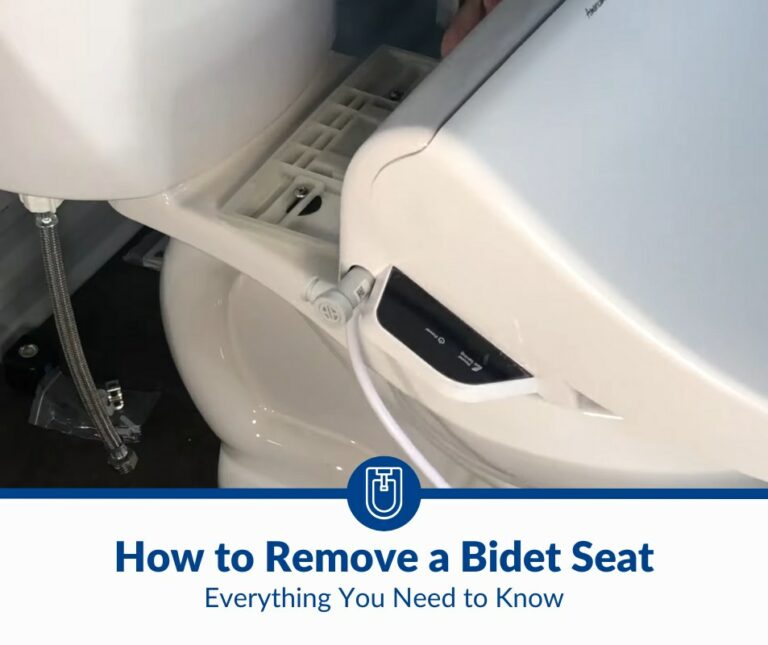Electric vs Non-Electric Bidet: Which Is Right for You?
Bidets are becoming increasingly popular due to their convenience, hygiene improvements, and more. However, it’s important to know if you should choose an electric or a non-electric bidet. Both systems are available for standalone bidets and bidet attachments that you can have in your bathroom.
Electric bidets are right for you if you prefer heated seats, thermostats, and air-drying features. Non-electric bidets are better if you want to save money and avoid electrical hookups that could take up more space and require new outlets. Both bidets can offer heated, high-pressure water streams.
Throughout this post, we’ll explain the differences between electric and non-electric bidets, the pros and cons of each, and which one is right for you. We’ll also provide you with maintenance tips and suggestions to help both bidets last longer (depending on which one you go with).
Differences Between Electric and Non-Electric Bidets
There are numerous differences between electric and non-electric bidets, all of which should affect your final decision. For example, non-electric bidets don’t offer nearly as many features, nor do they require electrical wires, thermostats, and other additions. Electric bidets are typically much more comfortable for most people, though.
Here’s an in-depth look at the five main differences between non-electric vs. electric bidets:
- Bidets Plus explains electric bidets require electricity from an outlet or a direct conduit. This may or may not affect your price range since most bathrooms have accessible outlets. Make sure you know how you’ll get power to your bidet before deciding if you want an electric setup.
- Non-electric bidets get all of their power from the water pressure going to your toilet or a standalone bidet. If you have plenty of water pressure, this won’t be an issue. However, homes with low water pressure might have reduced cleaning power when other water sources are being used.
- Electric bidets have more capabilities than non-electric bidets. If you’re considering heated seats, thermostats, air blowers, and other features, you’ll have to go with an electric bidet. The only features you get from a non-electric bidet are heated water (if it’s connected to your water heater), adjustable water pressure, and front-cleaning options.
- While both bidets can offer hot water connections, electric bidets typically have more control over the water temperature. Your non-electric bidet’s temperature is reliant on the water heater. If you don’t have a high-quality water heater, you won’t be able to heat the bidet very well.
- Electric bidet attachments often replace the whole toilet seat rather than connecting between the seat and the bowl. This is because the seat can often automatically open or close, heat up, and more. Also, electric bidet seats take up more space, so the lid has to be replaced to accommodate the extra room.
As you can see, there are plenty of reasons someone might prefer non-electric bidets over electric bidets (or vice versa). There are also very many similarities, including the fact that they both come in handheld, attachment, and standalone models. Additionally, electric and non-electric bidets offer a much more hygienic clean than toilet paper.
Advantages and Disadvantages of Both Bidet Types
Electric bidets tend to have more advantages than non-electric bidets in terms of offered features and comfort. That being said, non-electric bidets are much more convenient and affordable for most people. It’s worth weighing the pros and cons before deciding which bidet you’ll put in your home.
Let’s review the advantages and disadvantages of electric and non-electric bidets below.
Electric Bidets
Pros
- Air dryers prevent you from having to use toilet paper after the bidet. If you have an air dryer on your electric bidet, you can save a lot of money on toilet paper. You’ll also reduce your carbon footprint in the process. Air dryers can be much more comfortable and reduce the chances of leftover paper bits.
- According to Bio Bidet, you can get night lights installed if you have an electric bidet. This feature is great if you use the bathroom at night or when you don’t want to turn on the lights and wake everyone up. They’re waterproof, which means they work very well, even when they get wet from the bidet or the flushing toilet.
- Some electric bidets come with heated seats. Nothing beats a warm seat in the middle of winter. This convenient feature makes going to the bathroom much more comfortable, regardless of which time of the day you use the bidet. You don’t need seat covers to stay warm and clean.
- Many electric bidets include built-in thermostats to adjust the water temperature. These thermostats are much more useful and effective than non-electric bidets because the water temperature doesn’t rely on the water heater. Increase or decrease the bidet’s temperature to find your perfect comfort range.
- You can control the water’s oscillation and direction much easier with an electric bidet. While most non-electric bidets attempt to be one-size-fits-all, electric bidets often let you determine exactly where you want the water to hit. The subtle oscillations also remove as much debris as possible without making a mess.
Cons
- Electric bidets usually cost more than non-electric bidets. They have more features, which means they require more parts, labor, and so on. However, you can get a decent electric bidet without breaking the bank, especially if it only has heated water and adjustable water pressure.
- You’ll have to find out how you’ll get electricity to the bidet, which could require an electrician. Hiring a professional electrician could drastically increase the installation costs of an electric bidet. It could also take up a lot more room than you might’ve initially expected.
Non-Electric Bidets
Pros
- Non-electric bidets are much easier to install than electric bidets. You can install a non-electric bidet in less than half the time it takes to install an electric model. Furthermore, a non-electric bidet attachment can be installed in under five minutes. This makes them incredibly convenient for most homeowners.
- Most non-electric bidet attachments don’t require replacing the whole seat. They connect under the seat and above the bowl. Not only does this reduce the installation time, but it also means you can keep all of your toilet’s hardware. Non-electric bidet attachments are specially designed not to lift or alter the toilet lid.
- You won’t have to worry about increasing your electricity bill with a non-electric bidet. Non-electric bidets don’t use any electricity since all of the heat and water pressure comes from the inlet line. They solely rely on your home’s built-in plumbing, so there won’t be an increase in your monthly utility bill.
- Non-electric bidets work during power outages. A lack of electrical inlets means you won’t have to worry about storing extra toilet paper during electrical outages, extreme weather conditions, natural disasters, etc. This massive advantage is why so many people keep non-electric bidet attachments as backups.
- Bidet King reports that you can get hot water from a non-electric bidet, depending on your hot water heater’s temperature. Many people assume that you can’t heat a non-electric bidet’s water. If you have a high-quality water heater, you’ll be able to heat the water coming out of your bidet without any electricity.
Cons
- Non-electric bidets are severely limited in terms of air drying, water temperature, and more. Although you can adjust the water temperature, it’s not as reliable or influential as a thermostat. Furthermore, you’ll miss out on a handful of features that are exclusive to electric bidets and electric bidet attachments.
- You won’t be able to control the water pressure as well as electric bidets. All of the water pressure relies on your plumbing. When you have an electric bidet, you can use the electricity to adjust the pressure, even if you don’t have good plumbing, water pressure, or water heaters in your home.
Which Type of Bidet Lasts Longer?
Non-electric bidets usually last longer than electric bidets because they have fewer parts that can break or wear down. However, the bidet’s quality, routine maintenance, frequency of use, and many other factors will affect its longevity. For instance, a high-quality electric bidet that’s cleaned weekly will last longer than a low-quality, unclean non-electric bidet.
So, why might a non-electric bidet last longer than an electric bidet, or vice versa?
- If anything goes wrong with the electricity in your home, it could damage an electric bidet. This includes power shortages, exposed wires, faulty electrical outlets, and more. All of these issues can harm the bidet’s control board, rendering it useless. You might not even be able to change the water pressure.
- Non-electric bidets will lose their effectiveness if there’s a leak in the plumbing or if the water inlet is clogged. While this can happen with an electric bidet, it’s not as common since the higher water pressure typically prevents clogs from forming. It also means leaks are much more noticeable and easier to fix.
- Electric and non-electric bidets need to be cleaned quite often. Failure to clean the nozzle, seat, and adjustment knobs can severely reduce a bidet’s longevity and effectiveness.
The bidet’s quality and your maintenance routine are much more important than whether or not it requires electricity. These practices can quickly make or break any bidet, whether it’s a standalone unit, an attachment, or a handheld bidet.
For more information regarding the cleaning and overall maintenance of non-electric and electric bidets, proceed to the following sections.
How To Maintain a Non-Electric Bidet
To maintain a non-electric bidet, follow these instructions:
- Inspect the plumbing monthly and repair all leaks. Non-electric bidet attachments connect to the water inlet on your toilet. If there’s a leak between the plumbing connections, your toilet will leak. This also happens with standalone non-electric bidets. Use Teflon tape and silicone sealant to reduce and prevent leaks.
- Adjust the water inlet valve to determine the pressure. If your non-electric bidet has a pressure knob or button, you can open the valve all the way, then use the knob to change the pressure. If you don’t have a pressure knob on your bidet, you’ll have to determine the water pressure with the inlet valve’s direction.
- Maintain your water heater if you have a heated non-electric bidet. If the water heater is too high, your bidet’s water will be quite uncomfortable (for heated non-electric models). You can close the heated water inlet to prevent the water heater from affecting your bidet during the warmer months of the year.
- Clean the bidet spout with the self-cleaner every time you use it, then manually once per week. Most modern bidets have automatic cleaning attachments that spray the nozzle to remove debris. Use a soft sponge dipped in a mixture of warm water, a drop of dish soap, and a tablespoon of distilled vinegar to clean the nozzle manually.
As you can see, it’s not too difficult to maintain a non-electric bidet. The reduced maintenance procedures are some of the many reasons people often go for non-electric bidets instead of their electric counterparts.
Before you go with a non-electric bidet, consider the maintenance suggestions for electric bidets in the following section.
How To Maintain an Electric Bidet
To maintain an electric bidet, apply these steps:
- Check the electrical connections annually and the plumbing monthly. An electric bidet’s wires rarely have issues because they rely on your home’s power supply. If the outlet or conduit is in good condition, you likely won’t have any issues. The plumbing should be tightened and checked for leaks, much like a non-electric bidet.
- Test the control board with a multimeter if your electric bidet doesn’t work properly. Multimeters can check for voltage, amperage, wattage, and other forms of electric resistance. You can press the meter’s nodes against the corresponding nodes on the control board, depending on which part is experiencing issues.
- Clean the heated water tank monthly (if your electric bidet has a storage tank for heated water). Some electric bidets have storage tanks that hold warm water so that it’s always ready to use. Scrub the tank with a sponge and the aforementioned mixture of one cup of warm water, a drop of dish soap, and a tablespoon of distilled vinegar.
- Scrub the bidet nozzle weekly and use the self-cleaner after each use. This is the same process as cleaning a non-electric bidet’s nozzle, sprayer, or spout. Failure to clean the water outlet will result in bacterial growth that can cause all sorts of unwanted cleanliness and hygienic issues.
Electric bidets might require a bit more maintenance than non-electric bidets, but many people believe they’re worth the difference. Testing and tightening the electrical connections can help quite a bit since it reduces the chances of mechanical and electrical failure. It also prevents getting shocked or damaging the bidet’s control board.
Should You Choose an Electric or Non-Electric Bidet?
You should choose an electric bidet if you prefer warmth and comfort throughout the year. They’re also better if you want more control over the water pressure and temperature. However, you should choose a non-electric bidet if you want to reduce the installation and usage costs, especially if you have decent water pressure.
Below, you’ll find a handful of suggestions to help you know if you should choose an electric or a non-electric bidet.
- We recommend electric bidets if you live in a cold climate. They can come with heated seats, heated water, and heated air to dry yourself after using the bidet. All of these features make using the toilet significantly easier and less uncomfortable during the cold winter months.
- Consider getting a non-electric bidet if you want a simple setup with a quick installation process. They’re extremely basic, but they get the job done. Since non-electric bidets don’t need electrical wires, outlets, or conduits, they can be installed much more quickly and without professional assistance (in most cases).
- Electric bidets are the most optimal for those who don’t have adequate water pressure. If you’re stuck with reduced water pressure in your home or people use multiple water sources all of the time, electric bidets are the best option on the market for you. You can change the water pressure and temperature without relying on the plumbing pressure.
- Non-electric bidets are the go-to choice for people who don’t want to replace their toilet seats. If you get an attachment, you can remove the lid and seat, connect the attachment, and place the lid and seat back together. They’re much less bulky, which means they’re better for smaller bathrooms without room for standalone electric bidets.
Whether you choose an electric or a non-electric bidet, you’ll receive the same hygiene benefits. Bidets can make a world of difference in cleanliness and reducing your toilet paper usage. Remember, you still need a built-in air dryer or toilet paper to pat off the water after using the bidet.
Final Thoughts
Choosing a non-electric bidet will save time, space, and money. That being said, an electric bidet offers more amenities, including heated air, warm seats, thermostats, and more. Some of them even have smart features to maintain sanitation.







